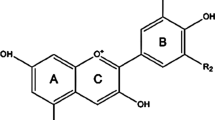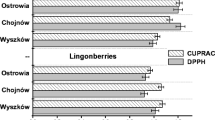Abstract
Phenolic acids and derivatives of quercetin in Indian (amla) and European gooseberry were determined by high-performance liquid chromatography with diode array detector. The calibration curves were constructed using phenolic compounds standards (the coefficient of determination (R 2) was 0.9990–0.9997 for phenolic acids and 0.9989–0.9994 for flavonols, respectively). The lowest detection limit was 0.28 mg L−1 and 0.35 mg L−1 for hyperoside and gallic acid, respectively, whereas the highest was 1.80 mg L−1 and 7.98 mg L−1 for quercetin and chlorogenic acid, respectively. The quantification limits calculated were 0.85–24.04 mg L−1 for hyperoside and chlorogenic acid, respectively. The predominant phenolic acid in amla and gooseberry is gallic acid: (5.37 ± 0.04) mg per 100 g of dry mass (d.m.) and (3.21 ± 0.03) mg per 100 g of d.m., respectively. The next one was caffeic acid, 0.65–1.22 mg per 100 g of d.m., followed by p-coumaric acid, 0.84–1.17 mg per 100 g of d.m. Out of the flavonols, rutin is predominant: (3.11 ± 0.13) mg per 100 g of d.m. and (2.12 ± 0.03) mg per 100 g of d.m., respectively. Anti-oxidant activity was also determined.
Similar content being viewed by others

References
Benzie, I. F. F., & Strain, J. J. (1996). The ferric reducing ability of plasma (FRAP) as a measure of “antioxidant power”: The FRAP assay. Analytical Biochemistry, 239, 70–76. DOI: 10.1006/abio.1996.0292.
Bhattacharya, A., Chatterjee, A., Ghosal, S., & Bhattacharya, S. K. (1999). Antioxidant activity of active tannoid principles of Emblica officinalis (amla). Indian Journal of Experimental Biology, 37, 676–680.
Brand-Williams, W., Cuvelier, M. E., & Berset, C. (1995). Use of a free radical method to evaluate antioxidant activity. LWT — Food Science and Technology, 28, 25–30. DOI: 10.1016/s0023-6438(95)80008-5.
British Pharmacopoeia Commission (2005). British Pharmacopoeia. London, UK: The Stationery Office.
de Ancos, B., González, E. M., & Pilar Cano, M. (2000). Ellagic acid, vitamin C, and total phenolic contents and radical scavenging capacity affected by freezing and frozen storage in raspberry fruit. Journal of Agricultural and Food Chemistry, 48, 4565–4570. DOI: 10.1021/jf0001684.
Deighton, N., Brennan, R., Finn, C., & Davies, H. V. (2000). Antioxidant properties of domesticated and wild Rubus species. Journal of the Science of Food and Agriculture, 80, 1307–1313. DOI: 10.1002/1097-0010(200007)80:9〈1307:: AID-JSFA638〉3.0.CO;2-P.
Farmakopea Polska. (2002). Farmakopea Polska (Vol VI). Warszawa, Poland: Polskie Towarzystwo Farmaceutyczne.
Floegel, A., Kim, D. O., Chung, S. J., Koo, S. I., & Chun, O. K. (2011). Comparison of ABTS/DPPH assays to measure antioxidant capacity in popular antioxidant-rich US foods. Journal of Food Composition and Analysis, 24, 1043–1048. DOI: 10.1016/j.jfca.2011.01.008.
Jain, S. K., & Khurdiya, D. S. (2004). Vitamin C enrichment of fruit juice based ready-to-serve beverages through blending of Indian Gooseberry (Emblica officinalis Gaertn.) juice. Plant Foods for Human Nutrition, 59, 63–66. DOI: 10.1007/s11130-004-0019-0.
Jose, J. K., Kuttan, G., & Kuttan, R. (2001). Antitumour activity of Emblica officinalis. Journal of Ethnopharmacology, 75, 65–69. DOI: 10.1016/s0378-8741(00)00378-0.
Khan, M. T. H., Lampronti, I., Martello, D., Bianchi, N., Jabbar, S., & Choudhuri, M. S. K. (2002). Identification of pyrogallol as an antiproliferative compound present in extracts from the medicinal plant Emblica officinalis: Effect on in vitro cell growth of human tumor cell lines. International Journal of Oncology, 20, 187–192.
Kim, D. O., Lee, K.W., Lee, H. J., & Lee, C. Y. (2002). Vitamin C equivalent antioxidant capacity (VCEAC) of phenolic phytochemicals. Journal of Agricultural and Food Chemistry, 50, 3713–3717. DOI: 10.1021/jf020071c.
Kohlmünzer, S. (2007). Farmakognozja. Warszawa, Poland: Wydawnictwo Lekarskie PZWL.
Kumar, G. S., Nayaka, H., Dharmesh, S. M., & Salimath, P. V. (2006). Free and bound phenolic antioxidant in amla (Emblica officinalis) and turmeric (Curcuma longa). Journal of Food Composition and Analysis, 19, 446–452. DOI: 10.1016/j.jfca.2005.12.015.
Pantelidis, G. E., Vasilakakis, M., Manganaris, G. A., & Diamantidis, G. (2007). Antioxidant capacity, phenol, anthocyanin and ascorbic acid contents in raspberries, blackberries, red currants, gooseberries and Cornelian cherries. Food Chemistry, 102, 777–783. DOI: 10.1016/j.foodchem.2006.06.021.
Perianayagam, J. B., Sharma, S. K., Joseph, A., & Christina, A. J. M. (2004). Evaluation of anti-pyretic and analgesic activity of Emblica officinalis Gaertn. Journal of Ethnopharmacology, 95, 83–85. DOI: 10.1016/j.jep.2004.06.020.
Polasa, K., Sesikaran, B., Krishna, T. P., & Krishnaswamy, K. (1991). Turmeric (Curcuma longa)-induced reduction in urinary mutagens. Food and Chemical Toxicology, 29, 699–706. DOI: 10.1016/0278-6915(91)90128-t.
Pornpimon, M., & Sakamon, D. (2008). Antimicrobial and antioxidant activities of Indian gooseberry and galangal extracts. LWT — Food Science and Technology, 41, 1153–1159. DOI: 10.1016/j.lwt.2007.07.019.
Prior, R. L., Cao, G., Martin, A., Sofic, E., McEwan, J., O’Brien, C., Lischner, N., Ehlenfeldt, M., Kalt, W., Krewer, G., & Mainland, M. (1998). Antioxidant capacity as influenced by total phenolic and anthocyanin content, maturity and variety of Vaccinium species. Journal of Agricultural and Food Chemistry, 46, 2686–2693. DOI: 10.1021/jf980145d.
Raghu, V., Platel, K., & Srinivasan, K. (2007). Comparison of ascorbic acid content of Emblica officinalis fruits determined by different analytical methods. Journal of Food Composition and Analysis, 20, 529–533. DOI: 10.1016/j.jfca.2007.02.006.
Sharma, N., Trikhaa, P., Athar, M., & Raisuddin, S. (2000). In vitro inhibition of carcinogen-induced mutagenecity by Cassia occidentalis and Emblica officinalis. Drug and Chemical Toxicology, 23, 477–484. DOI: 10.1081/dct-100100129.
Singleton, V. L., & Rossi, J. A., Jr. (1965). Colorimetry of total phenolics with phosphomolybdic-phosphotungstic acid reagents. American Journal of Enology and Viticulture, 16, 144–158.
Thakur, C. P., Thakur, B., Singh, S., Sinha, P. K., & Sinha, S. K. (1988). The Ayurvedic medicines, Haritaki, Amla and Bahira reduce cholesterol-induced atherosclerosis in rabbits. Indian Journal of Cardiology, 21, 167–172. DOI: 10.1016/0167-5273(88)90219-7.
Wang, S. Y., & Lin, H. S. (2000). Antioxidant activity in fruits and leaves of blackberry, raspberry, and strawberry varies with cultivar and developmental stage. Journal of Agricultural and Food Chemistry, 48, 140–146. DOI: 10.1021/jf9908345.
Author information
Authors and Affiliations
Corresponding author
Rights and permissions
About this article
Cite this article
Filipiak-Szok, A., Kurzawa, M. & Szłyk, E. Determination of anti-oxidant capacity and content of phenols, phenolic acids, and flavonols in Indian and European gooseberry. Chem. Pap. 66, 259–268 (2012). https://doi.org/10.2478/s11696-012-0151-5
Received:
Revised:
Accepted:
Published:
Issue Date:
DOI: https://doi.org/10.2478/s11696-012-0151-5



